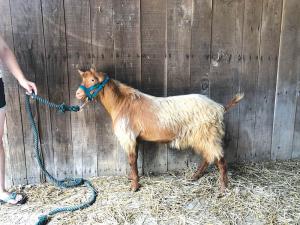2021 - Volume #45, Issue #5, Page #21
[ Sample Stories From This Issue | List of All Stories In This Issue | Print this story
| Read this issue]
These Goats Are Good Producers For Their Size
 |
Guernseys differ from some popular breeds in that they’re more of a mid-sized goat, not large like an Alpine or small like a Pygmy.
Sara Dzimianski is the Secretary for the Guernsey Goat Breeders of America. “As far as the color of their coats, they can be anywhere between a pale, creamy gold to a deep, rich, dark red-gold blend.”
What makes the Guernsey stand out from other dairy goat breeds is their productivity. For their body size and what they eat, Dzimianski says they’re one of the most efficient breeds of dairy goats available today.
Medium-sized goats will produce milk on par with larger breeds. Dzimianski says it’s not unusual to have a goat average a gallon of milk a day during her lactation.
“If you run a commercial goat dairy or are just producing milk at home for your family, the biggest question is how much money you spend for each gallon they produce,” she says.
Guernsey milk won’t be as high in butterfat as some of the other breeds. However, Guernsey milk is very good for making cheese.
“The milk has a very good cheese yield,” she says. “People also drink the milk. It’s generally mild-tasting milk as long as you feed them right.”
The other thing that really separates Guernseys from other breeds is their temperament. While other breeds can be feisty, Dzimianski says the Guernsey is more even-tempered.
“They can be a little more skittish than other breeds,” she says. “They’re much better when they’re bottle-fed as babies. They don’t adapt to coming into a milking parlor for the first time unless they have that interaction with humans when they’re little.
“If they’ve been handled properly early on, they’d make great 4-H projects because Guernseys are very easy to work with,” Dzimianski says. “A lot of people even keep them as pets.”
In commercial or home breeding herds, it won’t take a long time for the herd to add to its numbers.
“Gestation for goats is typically 145 – 155 days,” she says. “The females will typically average about 2 in each litter they birth. You can also breed the females right away in their first year.”
Contact FARM SHOW Followup, Sara Dzimianski, Purdue University Extension, 65 Park Avenue., Tell City, Ind. (ph 812 547-7084; sdzimian@purdue.edu).

Click here to download page story appeared in.

Click here to read entire issue
To read the rest of this story, download this issue below or click here to register with your account number.




